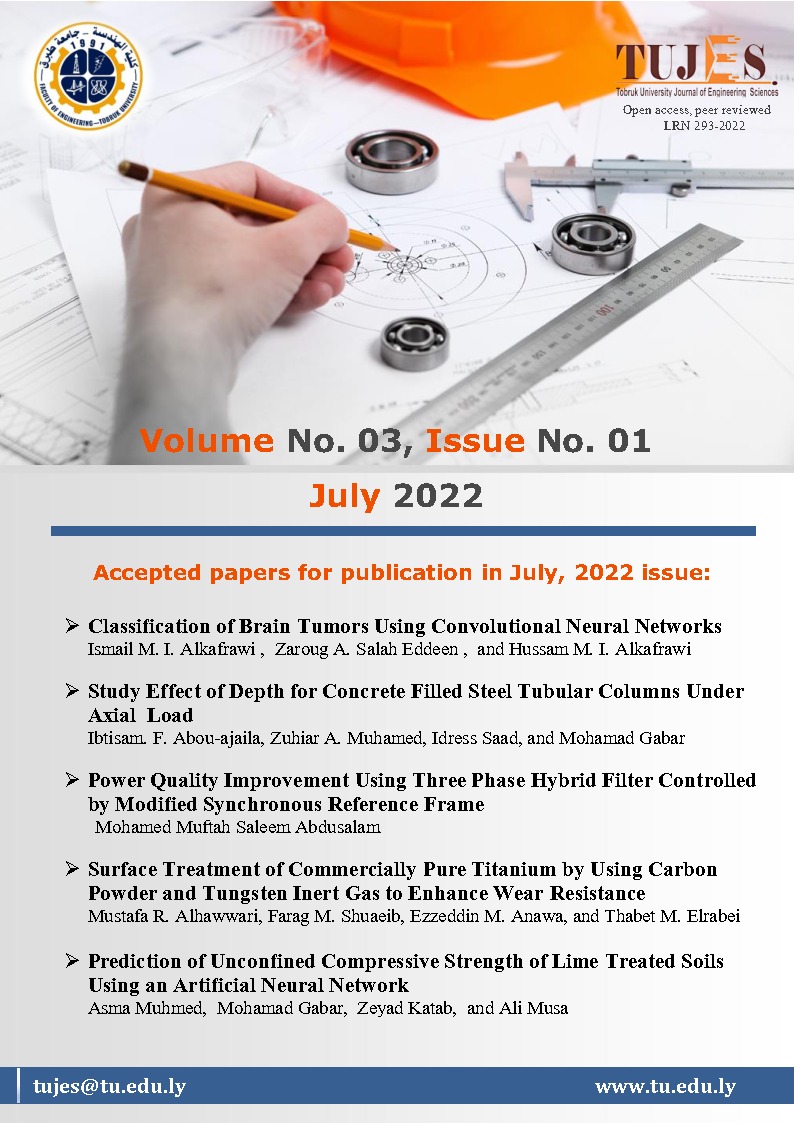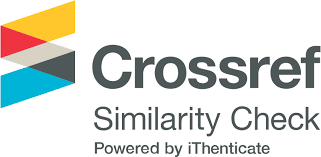Surface Treatment of Commercially Pure Titanium by Using Carbon Powder and Tungsten Inert Gas to Enhance Wear Resistance
DOI:
https://doi.org/10.64516/dws65g07Keywords:
Welding, TIG, WearAbstract
The aim of the present study, is to perform a Tungsten Inert Gas (TIG) surface alloying of a Commercially Pure Titanium (C.P.Ti) substrate with carbon powder under an atmosphere of pure argon gas. Experiments were carried out to introduce larger amounts of carbon into titanium substrate using tungsten inert gas (TIG) as a heating source. The technique includes forming grooves of different depths on the surface of the titanium; these grooves were then filled with carbon powder and then remelt the surface with a high energy TIG arc at a statistically planned manner (Taguchi Design of Experiment–DOE). This process led to melting part of titanium and consequently, the carbon powder dissolved in the melted pool forming Ti-C alloyed zone. Optical microscope, XRD, and SEM were used to study the microstructure, morphology, and dimensions of the alloyed zones. Also, micro hardness measurements were conducted across the depth of the alloyed zone. Finally, reciprocating wear test were also conducted to study the wear performance of the surface alloyed specimens. In conclusion, it is found that modifying the surface of Commercially Pure Titanium (C.P.Ti) by this method produced a suitable surface layer which has high hardness. This high hardness improved the wear resistance of C.P.Ti and consequently could be used in applications where wear and erosion resistance are required.
References
1. ASM handbook, Vol 2-properties and selection: nonferrous alloys and special—purpose materials. ASM International (1990).
2. A. Bloyce, P. Morton, T. Bell, (1994). ASM Handbook, OH, ASM International.
3. H. Huang, K. J. Winchester, A. Suvorova, B. R. Lawn, Y. Liu, X. Z Hu, J. M. Dell, & L. Faraone, (2006). Effect of deposition conditions on mechanical properties of low temperature PECVD silicon nitride films, Materials Science and Engineering: A, vol.435-436, pp.453-459.
4. S. Kumar, T. S. N. Sankara Narayanan, S. Ganesh Sundara Raman, & S. K. Seshadri, (2010), Thermal oxidation of Ti6Al4V alloy: Microstructural and electrochemical characterization, Materials Chemistry and Physics, vol.119, pp.337-346.
5. F.M. Shuaeib, and K.Y. Benyounis, (2016). Advances in Laser Nitriding Methods and Apparatus for Metals and Alloys. In: Saleem Hashmi (editor-in-chief), Reference Module in Materials Science and Materials Engineering. Oxford: Elsevier; 2016. pp. 1-20.
6. F.M. Shuaeib, and K.Y. Benyounis, (2016), An In-depth Investigation of Gas Nitriding of Stainless Steel: New DOE Parametric Studies and Optimization. In: Saleem Hashmi (editor-in-chief), Reference Module in Materials Science and Materials Engineering. Oxford: Elsevier; 2016. pp. 1-12.
7. A. Biswas, & J. Dutta Majumdar, (2009), Surface characterization and mechanical property evaluation of thermally oxidized Ti-6Al-4V. Materials Characterization, vol.60, pp.513-518
8. N. Tsuji, S. Tanaka & T. Takasugi, (2009), Effects of combined plasma-carburizing and shot-peening on fatigue and wear properties of Ti-6Al-4V alloy. Surface and Coatings Technology, vol.203, pp.1400-1405
9. H. Savaloni, K. Khojier & S. Torabi, (2010), Influence of N+ ion implantation on the corrosion and nano-structure of Ti samples. Corrosion Science, vol.52, pp.1263-1267.
10. P. V. Bharathy , D. Chu Nataraj, P. K. Wang, H., Yang, Q. Kiran, M. S. R. N. Silvestre , J. Albero. & D. Mangalaraj, (2010), Effect of titanium incorporation on the structural, mechanical and biocompatible properties of DLC thin films prepared by reactive-biased target ion beam deposition method. Applied Surface Science, vol.257, pp.143-150
11. T.S., Kim, Y.G., Park, & M.Y. Wey, (2003), Characterization of Ti-6Al-4V alloy modified by plasma carburizing process. Materials Science and Engineering A, vol.361, pp.275-280
12. J. H. Lee, N. N. Thadhani, (1997), Reaction synthesis mechanism in dynamically densified Ti+ C powder compacts. Scripta Materialia, vol.37, pp.1979-1985
13. X. Yin, I. Gotman, L. Klinger, & E. Y. Gutmanas, (2005), Formation of titanium carbide on graphite via powder immersion reaction assisted coating. Materials Science and Engineering A, vol.396, pp.107-114.
14. B. Cochepin, V. Gauthier, D. Vrel & S. Dubois, (2007), Crystal growth of TiC grains during SHS reactions. Journal of Crystal Growth, vol.304, pp.481-486.
15. Y. Luo, H. Jiang, G. Cheng & H. Liu, (2011), Effect of carburization on the mechanical properties of biomedical grade titanium alloys. Journal of Bionic Engineering, vol.8,pp.86-89.
16. S. K. Wu, C. Y. Lee & H. C. Lin, (1997), A study of vacuum carburization of an equiatomic TiNi shape memory alloy. Scripta Materialia, vol.37, pp.837-842.
17. A. F. Saleh, J. H. Abboud & K. Y. Benyounis, (2010), Surface carburizing of Ti-6Al-4V alloy by laser melting. Optics and Lasers in Engineering, vol.48, pp.257-267.
18. F. Adib Hajbagheri , S. F. Kashani Bozorg and A. A. Amadeh, Microstructure and wear assessment of TIG surface alloying of CP-titanium with silicon, J Mater Sci (2008) 43:5720–5727.
19. A. Monfared, A.H. Kokabi, S. Asgari, (2013), Microstructural studies and wear assessments of Ti/TiC surfacecomposite coatings on commercial pure Ti produced by titanium cored wires and TIG process, Materials Chemistry and Physics, 2013.
20. S. Chatterjee, T.K. Pal, (2003), Wear behaviour of hardfacing deposits on cast iron Wear Volume 255, Issues 16, August–September 2003, Pages 417-425, https://www.sciencedirect.com.
21. C. Fan, M.C. Chen, C.M. Chang, W. Wu, (2006), Microstructure change caused by (Cr, Fe)23C6 carbides in high chromium Fe–Cr–C hardfacing alloys, Surface and Coatings Technology Volume 201, Issues 3–4, 5 October 2006, Pages 908-912, https://www.sciencedirect.com
22. K. H. Zum Gahr, (1998), Wear by hard particles, Tribology International, Volume 31, Issue 10, October 1998, Pages 587-596, https://www.sciencedirect.com.
23. ASTM-G137, Standard Test Method for Ranking Resistance of Plastic Materials to Sliding Wear Using a Block-On-Ring Configuration
Downloads
Published
Issue
Section
License
Copyright (c) 2025 Mustafa R. Alhawwari, Farag M. Shuaeib, Ezzeddin M. Anawa (Author)

This work is licensed under a Creative Commons Attribution 4.0 International License.













